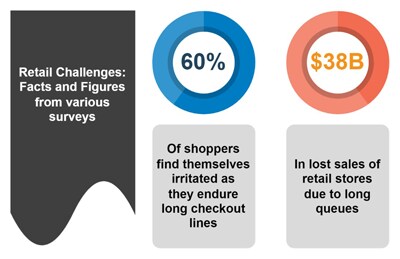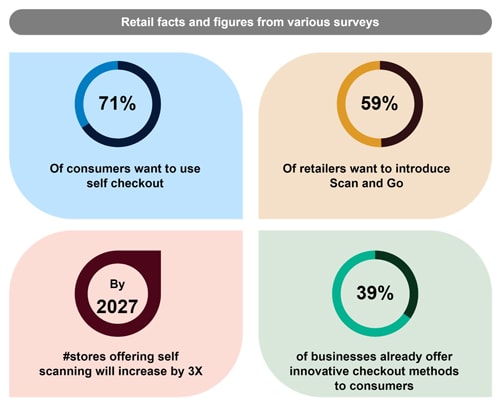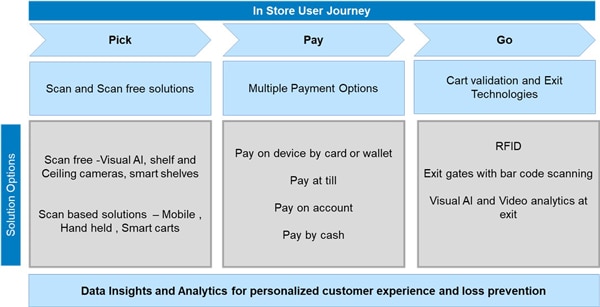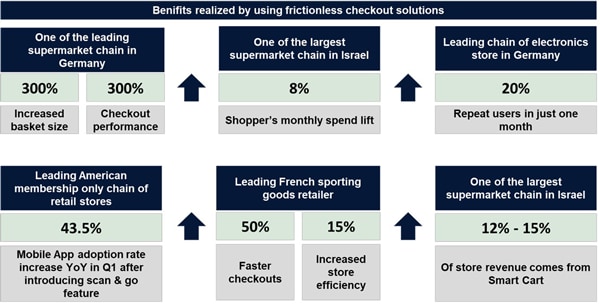Experience
Frictionless Checkout – The Future of Shopping
This whitepaper outlines the difficulties and obstacles that retail customers encounter during their in-store shopping experiences, along with various solutions to address these issues and key considerations.
Insights
- This white paper provides readers with insights into essential retail facts and challenges, highlighting how retailers are leveraging cutting-edge technologies such as AI, ML, RFID, and Scan and Go devices to address these issues and create a seamless shopping experience.
- Additionally, this white paper offers guidance on key considerations for selecting solution options and highlights the tangible benefits realized by both retailers and wholesalers.
Introduction
We live in a world where every industry is trying to create a better experience for their customers. This is being achieved by providing completely new offerings relevant to their customers or by reducing the friction in the current offerings. We, the customers, expect no different from in our personal retailing experience. Key part of this retailing experience is the process of in store checkouts. There exists friction in these in store checkout processes. Similar frictions have existed in the online checkout process but have been resolved through concepts like single click checkouts in the online digital journeys.
Now retailers, wholesalers are experimenting with similar in store experience to provide their customers with a ‘Frictionless Checkout.’
Current In Store Shopping Challenges
Convenience and ease of completing your shopping has been each customer’s need. Current “Amazon Prime” generation is demanding a very quick, slick “in and out” frictionless store shopping experience. Customers are expecting the convenience of online shopping in their in-store experience as well.
Once in store they do not want to stand in queues during peak times and would like to have various checkout options to complete their shopping whether it is a small basket or a big weekly trolley shopping. These wait times (and associated bad customer experience) get especially pronounced when trolley sizes increase and there are several special scenarios that may need special attention from store employees e.g., markdowns, non-bar-coded fresh produce, age restricted products etc.
Another challenge customers are expecting is a complete omnichannel experience. Digital savvy customers want to utilize the digital tools available at their disposal to start their shopping journey before they come into the stores, be it research of what they want to buy or be it creating the shopping list for their weekly shopping. Customer are looking for an end-to-end omnichannel shopping experience.
For retailers and wholesaler’s checkout costs (employee costs, printing costs, hardware costs) are a substantial portion of their instore spend. Any operational efficiency they can achieve through digitization of their checkout process will help redeploy their checkout employees to more value added “selling” activities.
Current shopping experience does not provide any information about the customer’s needs, shopping navigation needs, shopping preferences etc. Any digitization of this shopping experience will help provide useful insights on customer shopping behaviors and provide retailer useful information to tailor its offerings for individual or segments of customers.
Figure 1. Retail facts and figures - Challenges

Frictionless checkout – The future of shopping
Frictionless checkout helps to resolve the mentioned challenges, aims to improve consumer shopping experience, and create a barrier free, seamless purchasing journey. A lot of retailers are adapting several ways to enhance instore shopping experience using fully autonomous store or Scan and Go solutions backed by innovative technology solutions. Some of the key examples are Amazon Go and EDEKA. Amazon Go stores offering ‘Just walk out’ experience with no traditional checkout lanes and EDEKA offering scan and go mobile application and Easy Shopper smart carts.
Figure 2. Retail facts and figures – Market direction and consumer needs

The market size for global self-checkout systems is expected to expand at a CAGR of 16.2% from 2022 to 2030, reaching USD 13.98 billion by 2030
- Fortune Business Insights, 2022
Frictionless checkout focuses on the three key aspects of the instore journey- Pick product which includes scan and scan free solutions, Pay that provides multiple payment options and Go that comprises of exit technologies.
These elements coming together in a seamless way provides a rich automated shopping experience to customers.
Figure 3. Frictionless checkout services and options

History of Scan & Go Devices
‘Scan & Go’ has existed in different formats for the last 20 years. These scan and go devices were initially handheld scanners (e.g., Zebra and Symbol devices) with the ability to read 1D barcodes. While most of the adoption was in the grocery sector, other categories of retailing like apparel, cosmetics, convenience etc. also started to provide their customers with the ability to ‘Scan & Go.’
These devices started to provide the customers the ‘power’ to complete their shopping, but this provided an additional headache of rising shrinkage and theft (both intentional and unintentional). And to supplement this convenience retailers had to start adding further loss prevention techniques.
These devices were replaced by the widespread use of mobile phones as a ubiquitous powerful device in every customer’s hands. Many retailers started to move away from these devices and further provided new apps in the hands of the customers to scan their shopping using their mobile phones including the ability to ‘Pay and Go’ feature on these devices.
These were more appropriate for small baskets and very handy for ‘Grab & Go’ customers in urban centers and retail service stations. There was still a gap to make the trolley size, big basket shopping as seamless as the small basket. Recently with this in mind a lot of technology providers have started to experiment with both the smart carts and with retrofit devices on the existing trolley fleets. There are a number of these solution providers who are in various stages of experimentation and wider rollout with retailers across all major markets.
Key benefits of a frictionless shopping experience
When designing a frictionless shopping experience there are a few key benefits that retailers and wholesalers should consider offering customers.
- Ease of Shopping Experience
Customer are looking for easy shopping experience online and instore. Designing a frictionless checkout journey needs to look at various aspects including ease of pick up and price check of instore items, easy availability of personalized prices and promotions, reducing queues by providing flexible payment options and easy checkouts. - Ease of payments and flexible checkout options
Flexible payment options ease the customer journey and reduces the wait times at checkout queues. Retailers should provide customers with flexible payment options based on their personal or business needs. These include payment on device by card, on account (B2B), payment by cash at the till or payment by card at the till. Providing multiple options enables customers to choose the best fit option based on his requirements and provides him the much-desired flexibility. Also, providing payment directly on in store scan devices provides a better experience and reduces queues at checkout. - Real time information on basket size, price offers and discounts
Showing the real-time basket, overall cost upfront along with personalized promotions and discounts helps customers to make decisions on which products to buy and keeps them informed on options and enhances engagement throughout the journey. Retailers should focus on real time integrations with existing enterprise systems to fetch price, offers and promotions. - Improved customer service
Retailers should invest on providing real time assistance instantly in case customer get s stuck during their shopping journey. Customers should be able to ask for help and the help should arrive instantly. The store assistant should know the location of the user and provide help either remotely or should be able to walk to the customer location. Address common issues while shopping – Customer is not able to locate a product or Scan not working or age verification for certain categories. - Reduced queues
A key concern from most customers today is the wait time in queues that increases their overall shopping time and provides not so optimal shopping experience. Retailers need to select autonomous shopping means such as scan or scan free solution with right payment technologies coupled with exit solutions. - Omnichannel connected experience
A key element of the in store smart shopping experience is to provide a seamless connectivity between online and instore worlds using omnichannel connected journeys involving use cases like exploring in store product availability online, creating a wish list to shop and then transferring these to in store devices like handheld devices, smart cart devices etc. Once, the shopping is complete user should be able to see invoices, order details and digital bills in online channels. - Provide Sustainable options – Digital bills and receipts
Provide customers a paper free and environment friendly way to get invoices and bills digitally directly on their mobile and web application. Retailers can save the cost on paper and printing and customers can view all Digital receipts in a central location.
Benefits for the Retailers
Frictionless shopping experience provides benefits not only to the shoppers, but also provides great benefits to Retailers.
- Reduce store space utilization.
Traditional checkout requires more store space, including multiple counters. Self-scan or scan free solutions help in reducing the number of staffed counters. These counters are usually replaced by dedicated self-checkout lanes or exit gate solutions there by reducing some store space utilization that could be leveraged for some other work. - Reduce labor cost and better labor allocation.
By providing self-scanning solutions, retailers can reduce labor at checkout counters and redeploy them elsewhere such as customer support or shelf replenishment to improve operational efficiency. - Better insights and personalization using data.
Scan and go solution and some scan free solutions provide in store customer behaviors tracking and analytics. Throughout the customer in store journey, customer behavior is tracked using in application behavior tracking or video analytics and can be linked to online eCommerce purchasing patterns to generate personalized recommendations, sales forecasting, and targeted marketing strategies. - Reduce queues and enhanced customer experience.
Addressing this key customer pain point in stores and providing a faster checkout experience enhances customer experience and helps in stickiness, loyalty, and retention. - Loss Prevention
Scan and Go or Pick and Go is known to increase some loss as the control is given more in the hands of customers. However, with better loss prevention techniques offered by solution providers today the shrinkage can be prevented.
The techniques deployed in loss prevention include using Visual AI, Video analytics, User behavior analytics, Creating loss prevention rules to alert store agents and RFID tags for expensive items. - Real time store monitoring
Some of the smart cart solutions offer side cameras that could be leveraged for store monitoring and also checking the stock availability in shelves. - Improved inventory management
Creating a wish list for instore shopping on mobile devices helps in better demand visibility and stock management. Also, some advanced solutions like smart carts have side cameras which could help in tracking shelf inventory levels and replenishing them as required. In scan and Go solutions, each item is scanned before it is placed in cart and hence helps in real time monitoring of inventory levels also provide details on products that are in demand and are popular. - Better options for marketing and retail media
Using some of the advanced solutions in scan and go space such as smart carts provide a larger screen size and helps to promote retail media. This provides new revenue generating options to Retailers.
Market solution options and Industry trends to achieve frictionless shopping experience.

Frictionless shopping experience market has been evolving and there are multiple solution options available today for retailers to select from. On one hand, we see the use of mobile applications and handheld devices for scanning products and are some of the established technologies in the market which have been tried and evaluated on a global scale. On the other hand, there are other emerging technologies like Smart carts, RFID based checkouts, and Pick and Go (scan free). Some of the retailers implement multiple options and experiment with different options in their different store formats. Providing multiple options also gives flexibility to shoppers to choose the most convenient option. The details of the key options are provided below.
- Mobile app scan and go
Mobile app scan and go is the most common and widely used approach by retailers today to start their frictionless checkout journey. This could be an extension of existing commerce application, or a new purpose-built application. Many vendors like Extenda Retail, Shopreme, MishiPay provide white label solution applications that could be tailored for specific organization needs and could be easily rebranded. These vendors offer a wider ecosystem of supporting applications, hardware and software and offer out of the box features for customer app, agent app and loss prevention management dashboards.
While mobile apps help in creating and omnichannel experience, the disadvantage seen with the mobile applications to provide a consistent brand experience and performance to all customers and hence, retailers move on to explore further advanced purpose-built options. - Dedicated handheld device Scan and Go
Many customers do not prefer to use own mobile phones for in store shopping. For this reason, retailers are also providing purpose built dedicated handheld devices as an alternative shopping option. These devices include rugged devices from vendors like Zebra, Datalogic, Honeywell vendors.
Handheld devices provide similar experience to all device users with purpose built powerful capabilities and a performant built in bar code scanner. A lot of new generation devices like Zebra PS30 also provide pay- on- device options by tap to pay using integrated NFC technology or payments could be done via transferring to till. Most of the white label vendors providing mobile scan and go applications also provide white label applications that run on these rugged devices. - Smart Carts – Dedicated and Retrofit options
Smart cart is the next gen revolution in scan and go solutions. A lot of retailers have implemented smart cart solution, and some are in experimentation phase. Smart carts provide a more E2E automated experience to the customers. These smart carts offer built in scanner, leverage visual AI and weight sensors for loss prevention and to avoid shrinkage. Because of the better real estate, smart carts also provide opportunities to include floor guidance maps, retail media and better marketing and promotion options.
Many smart cart vendors provide a retrofit design option where the device could fit on any existing cart including closed and flatbed trolleys used in wholesale world. This saves upfront investment cost as the existing carts could be reused. These vendors also offer purpose built dedicated carts for retailers. These dedicated carts come with integrated device, integrated barcode scanners and integrated weight sensors.
Some of the popular vendors in this space are Cust2Mate, Veeve, KBST , Shopic and EasyShopper. - Pick and Go
Pick and go is another innovative emerging technology in frictionless shopping world where customers can walk into a Pick and Go store, pick up items from shelves and leave without going through a traditional checkout process. This is more popular today in the convenience store formats or smaller sized stores and will take some time to enter large store formats.
Various techniques have been used to implement Pay and Go solutions. Cameras and sensors installed in ceiling and shelves recognize customer and their purchases and create a virtual cart on their mobile applications. Visual AI helps to identify accurate products and customer behavior to prevent loss.
Another popular approach that is gaining momentum in the Pick and Go space is the RFID based solutions. In RFID-based systems, customers pick up products and place them in designated RFID boxes at the store exit. The technology detects all cart items that need to be paid for. RFID helps prevent loss by ensuring that all items leaving the store are accounted for.
Trigo, Amazon(Just Walk Out) ,Infosys Visual AI and MishiPay are key vendors in this space, empowering multiple retailers across globe.
Key Considerations for solution options selection
- Consumer demographics
With the wide range of solution options available retailers need to choose and adapt the based on their consumer demographics. Technology adoption, age of their consumers, and the store format will dictate the right solution for their consumers. High mobile adoption of the existing scan & go solution is a good indicator of the consumer’s appetite to take on new innovative solutions. Need of convenience and the weight of the products being sold in store will influence the right solution chosen by retailers for their consumers. - Marketing needs
All Scan & Go solutions provided by a retailer can increase the ability of the retailer to catch consumers attention and capture marketing opportunities. The right solution will give the ability for the retailer to monetize the current investments in automated marketing solutions. Different solutions provide the retailer a different form factor to push their marketing content. Consideration needs to be given to the right form factor for the right marketing content. Such marketing content needs to be aligned with any supplier paid campaigns and product/event specific marketing.
Benefits realized across retailers
Figure 4. Retail facts and figures – Benefits realized.

Creating a strong Business Case
Any Scan & Go solutions rolled out by a retailer and the upfront investments these solutions require need to have a strong business case with a typical ROI in 3-5 years.
Many providers of these solutions provide the capability to amortize the upfront costs of such investments and ability to pay for such rollout through the Opex bucket rather than the Capex bucket.
Business case benefits can be achieved under the following categories:
Operational Efficiency
- Cost take-out from store operations.
- Savings in store costs.
Store Sales Uplift
- Increase in Click and Collect in store picking orders.
- Increased “Selling” workforce in store.
- Real time promotions and retail media.
Conclusion
Streamlining the shopping experience through frictionless technologies is poised to become the defining trend in retail. Forward-thinking organizations should prioritize this approach within their CIO strategy. Frictionless shopping offers a win-win scenario for both consumers and retailers, as evidenced by its numerous advantages. By building a compelling business case and selecting the right solutions, companies can empower shoppers to reap the full benefits of a frictionless shopping journey. The selection of the right solution option depends on numerous factors like customer expectations, demographics, store formats etc. and must be done carefully to get maximum benefits. Retaining an omnichannel connected experience across channels is a key to success. Retailer should invest in technologies based on Computer vision, Visual AI, and ML for shrinkage management.
To do a proper evaluation and design the solution organizations will need a strong consulting and SI partner like Infosys. Infosys offers end to end services in smart checkout area from business case creation, strategic consulting to execution.
References
- Digital Invoice | Scan & Go (scanandgo.com)
- https://www.extendaretail.com/
- https://www.shopreme.com/features/
- https://mishipay.com/
- HOME - Cust2Mate 3.0
- https://easy-shopper.com/
- https://veeve.io/
- https://www.kbst-gmbh.de/en/
- Home - Shopic
- Beyond traditional checkouts: the evolution of scan and go technology in retail (fynd.com)
- Tesco opens its first checkout-free store (bbc.com)
- Retail Tech Case Study: Decathlon India boosts shopping experience, increases efficiency by 15% (indiaretailing.com)
- Beyond traditional checkouts: the evolution of scan and go technology in retail (fynd.com)
- Sam’s Club Evolves Its Scan & Go App, Merging Digital and Physical Experiences | Business Wire

Subscribe
To keep yourself updated on the latest technology and industry trends subscribe to the Infosys Knowledge Institute's publications
Count me in!









